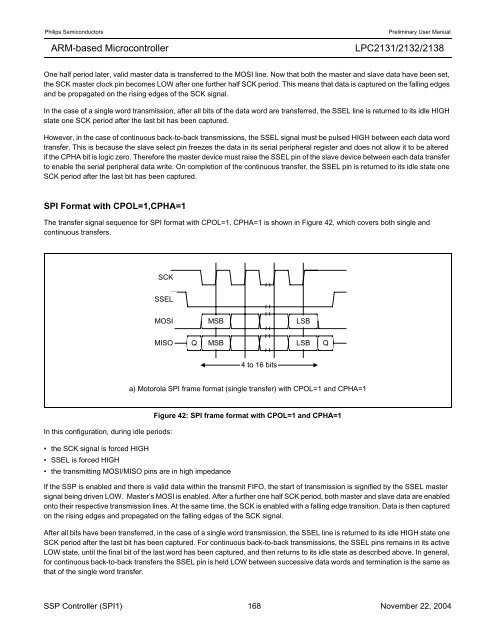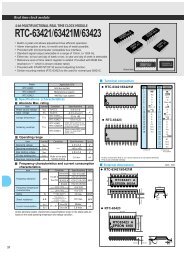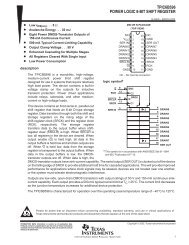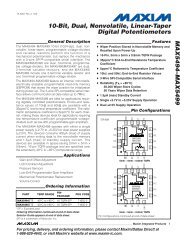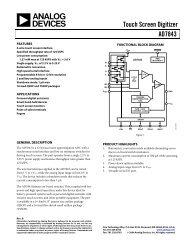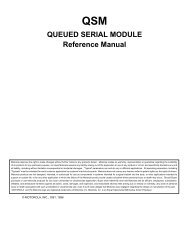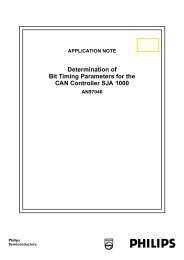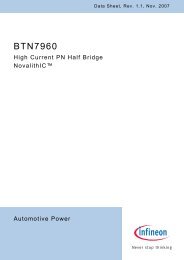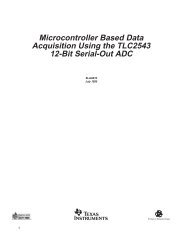Create successful ePaper yourself
Turn your PDF publications into a flip-book with our unique Google optimized e-Paper software.
Philips Semiconductors Preliminary <strong>User</strong> <strong>Manual</strong><br />
ARM-based Microcontroller<br />
<strong>LPC2131</strong>/<strong>2132</strong>/<strong>2138</strong><br />
One half period later, valid master data is transferred to the MOSI line. Now that both the master and slave data have been set,<br />
the SCK master clock pin becomes LOW after one further half SCK period. This means that data is captured on the falling edges<br />
and be propagated on the rising edges of the SCK signal.<br />
In the case of a single word transmission, after all bits of the data word are transferred, the SSEL line is returned to its idle HIGH<br />
state one SCK period after the last bit has been captured.<br />
However, in the case of continuous back-to-back transmissions, the SSEL signal must be pulsed HIGH between each data word<br />
transfer. This is because the slave select pin freezes the data in its serial peripheral register and does not allow it to be altered<br />
if the CPHA bit is logic zero. Therefore the master device must raise the SSEL pin of the slave device between each data transfer<br />
to enable the serial peripheral data write. On completion of the continuous transfer, the SSEL pin is returned to its idle state one<br />
SCK period after the last bit has been captured.<br />
SPI Format with CPOL=1,CPHA=1<br />
The transfer signal sequence for SPI format with CPOL=1, CPHA=1 is shown in Figure 42, which covers both single and<br />
continuous transfers.<br />
SCK<br />
SSEL<br />
In this configuration, during idle periods:<br />
MOSI MSB<br />
MISO Q<br />
MSB<br />
a) Motorola SPI frame format (single transfer) with CPOL=1 and CPHA=1<br />
the SCK signal is forced HIGH<br />
SSEL is forced HIGH<br />
the transmitting MOSI/MISO pins are in high impedance<br />
4 to 16 bits<br />
Figure 42: SPI frame format with CPOL=1 and CPHA=1<br />
If the SSP is enabled and there is valid data within the transmit FIFO, the start of transmission is signified by the SSEL master<br />
signal being driven LOW. Master’s MOSI is enabled. After a further one half SCK period, both master and slave data are enabled<br />
onto their respective transmission lines. At the same time, the SCK is enabled with a falling edge transition. Data is then captured<br />
on the rising edges and propagated on the falling edges of the SCK signal.<br />
After all bits have been transferred, in the case of a single word transmission, the SSEL line is returned to its idle HIGH state one<br />
SCK period after the last bit has been captured. For continuous back-to-back transmissions, the SSEL pins remains in its active<br />
LOW state, until the final bit of the last word has been captured, and then returns to its idle state as described above. In general,<br />
for continuous back-to-back transfers the SSEL pin is held LOW between successive data words and termination is the same as<br />
that of the single word transfer.<br />
SSP Controller (SPI1) 168 November 22, 2004<br />
~<br />
~ ~ ~<br />
~<br />
~<br />
LSB<br />
LSB Q


